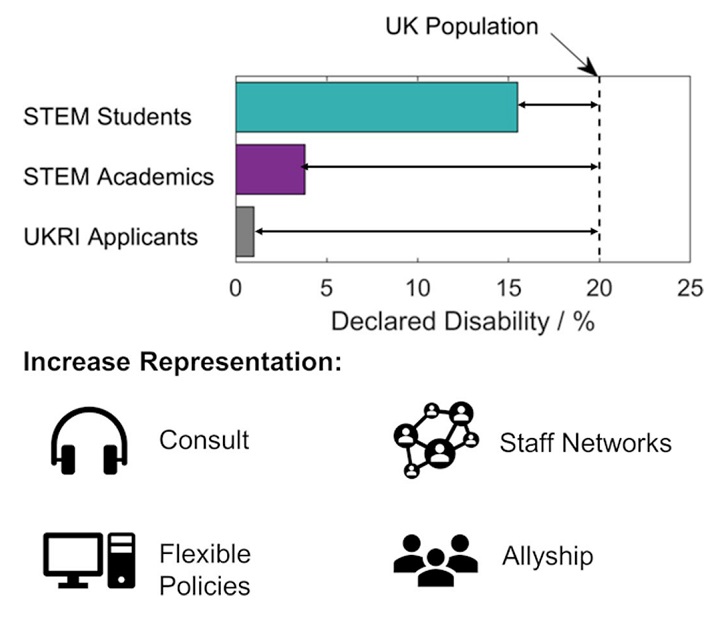Towards Genuine Inclusion of Disabled Scientists Post Pandemic
The COVID-19 pandemic has impacted us all but the consequences have not been felt equally. In a new article, Dr Julia Sarju suggests strategies for the genuine inclusion of disabled scientists and argues that the time has never been more important to take action.

Disabled people are a sizable minority, with 1 in 5 people in the UK and 1 in 8 people in the US identifying as having a disability. In 2018–2019, 15.5 % of first-degree STEM students studying in the UK declared at least one disability, but analysis of the destinations of STEM graduates found that STEM graduates with a known disability are more likely to be unemployed six months after graduation compared to their peers with no known disability. Furthermore, the rates of known disability in academia and STEM careers are lower compared to the general population, and this difference becomes more significant with increasing seniority. Discrimination, insufficient accessibility, and attitudinal issues all contribute both to the under-representation of disabled scientists and the declaration of disability status.
There are at least two major issues here. The first is that there is a large number of scientists who do not feel they can be their whole selves in their workplaces, are not accessing accommodations or support to remove barriers, and may have to moderate what they say and how they act to “pass”. The second is that disabled people do not have equitable access to scientific careers.
In terms of the Covid pandemic, the UN Sustainable Development Goals have been updated to highlight that disabled people are amongst those “being hit hardest by the pandemic” and that “existing patterns of discrimination may be entrenched by the crisis”. Disabled scientists have experienced significant and diverse challenges, including difficulties and delays accessing health, and social care, and variable levels of digital accessibility. Scientists who have been shielding for medical reasons have not been able to access labs and equipment and may have also felt isolated from colleagues and networks. Uncertainty, health and hygiene concerns, and isolation have been particularly challenging for many with mental ill-health. Furthermore, frequent, and public discussion of underlying health conditions has made some feel that their rich and important life as a disabled person is somehow less valued.
Writing in Chemistry A European Journal to address these issues, Dr Julia Sarju, Lecturer in Chemistry Education, makes a number of key recommendations:
- Decision-making: Ensure meaningful consultation with disabled staff and representation of disabled staff in committees and decision-making groups.
- Advocacy: Allies must advocate for scientists from under-represented groups to lessen the burden and risks of activism.
- Networks: Work with and support disabled staff networks.
- Web-accessibility: Ensure online content including websites, learning management systems, and apps are accessible. At the minimum they should meet the EU Web Accessibility Directive by being perceivable, operable, understandable, and robust.
- Flexibility: Continue to offer flexible and remote working polices as recommended by the World Health Organisation, and to continue to allow virtual attendance of conferences and meetings, with a plan for inclusivity.
Reflecting on the experiences of disabled scientists, Dr Sarju says:
“Scientific institutions and workplaces must learn from the experiences of disabled scientists, champion and support disabled leaders, ensure the visibility of positive senior disabled role models, and adopt inclusive practices and policies. A culture change is required to ensure that disabled people are valued and recognised as scientists, innovators, and leaders. By ensuring we are inclusive of and supportive to as diverse a range of scientists as possible we can make sure that scientists represent the wider population, making space for new ideas, and ultimately new and exciting scientific developments.”
The full article can be found in Chemistry A European Journal where it is published open access.
University of York has the INCLUDE network for disabled staff, which is part of the National Association of Disabled Staff Networks.